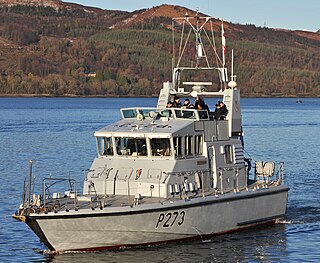
In naval terminology, a destroyer is a fast, maneuverable, long-endurance warship intended to escort larger vessels in a fleet, convoy or battle group and defend them against powerful short range attackers. They were originally developed in 1885 by Fernando Villaamil for the Spanish Navy as a defense against torpedo boats, and by the time of the Russo-Japanese War in 1904, these "torpedo boat destroyers" (TBDs) were "large, swift, and powerfully armed torpedo boats designed to destroy other torpedo boats". Although the term "destroyer" had been used interchangeably with "TBD" and "torpedo boat destroyer" by navies since 1892, the term "torpedo boat destroyer" had been generally shortened to simply "destroyer" by nearly all navies by the First World War.

A torpedo boat is a relatively small and fast naval ship designed to carry torpedoes into battle. The first designs were steam-powered craft dedicated to ramming enemy ships with explosive spar torpedoes. Later evolutions launched variants of self-propelled Whitehead torpedoes.

A cutlass is a short, broad sabre or slashing sword, with a straight or slightly curved blade sharpened on the cutting edge, and a hilt often featuring a solid cupped or basket-shaped guard. It was a common naval weapon during the early Age of Sail.

Goalkeeper is a Dutch close-in weapon system (CIWS) introduced in 1979. It is an autonomous and completely automatic weapon system for short-range defence of ships against highly manoeuvrable missiles, aircraft and fast-manoeuvering surface vessels. Once activated the system automatically undertakes the entire air defence process from surveillance and detection to destruction, including the selection of the next priority target.

Future planning of the Royal Navy's capabilities is set through periodic Defence Reviews carried out by the British Government. The Royal Navy's role in the 2020s, and beyond, is outlined in the 2021 defence white paper, which was published on 22 March 2021. The white paper is one component of the Integrated Review of Security, Defence, Development and Foreign Policy, titled as Global Britain in a Competitive Age which was published on 16 March 2021.

The Altmark incident was a naval incident of World War II between British destroyers and the German tanker Altmark, which happened on 16–17 February 1940. It took place in what were, at that time, neutral Norwegian waters. On board the Altmark were some 300 allied prisoners, whose ships had been sunk by the pocket battleship Graf Spee in the Southern Atlantic Ocean. British naval forces cornered the tanker and later the destroyer Cossack attacked the German ship near the Jøssingfjord and freed all the prisoners, killing eight German seamen with firearms and wounding ten others, five of them seriously. A British and a Norwegian sailor were also seriously wounded in the action. Germany claimed that the attack was a grave violation of international law and of Norwegian neutrality, and, in a propaganda broadcast, criticised Churchill's "mentality" of congratulating his navy for "shooting unarmed men".

The Weapon class was a class of destroyers built for the British Royal Navy towards the end of World War II. They were the smaller counterpart to the Battle class and were the first new destroyer designs for the Royal Navy since the Second World War Emergency Programme. 20 ships were planned, of which only 13 were laid down and 7 were launched, but the cessation of hostilities resulted in only 4 being completed for service. Two of the ships had been previously ordered as part of the planned C class, or 15th Emergency flotilla, of 1944, but the orders were changed to the new design.

The Gibraltar Squadron is a unit of the British Royal Navy. It is the only seagoing Royal Naval unit based in Gibraltar, attached to British Forces Gibraltar. In 2020 its two 16 m patrol ships HMS Scimitar and HMS Sabre were replaced by two Archer class boats, HMS Pursuer and HMS Dasher. These vessels are, in turn, being replaced by two new Cutlass-class fast patrol boats with a maximum speed of up to 40-knots. The first new vessel of this class, HMS Cutlass, arrived in Gibraltar in November 2021. The squadron also uses three Pacific 24 rigid-hulled inflatable boats, crewed by a team of 26 people. The 2021 defence white paper indicated that henceforth, one River-class offshore patrol vessel, HMS Trent, would also be permanently based in Gibraltar for operations in the Mediterranean and in the Gulf of Guinea.
Several ships of the Royal Navy have been named HMS Pursuer.
Thirteen ships of the Royal Navy have borne the name HMS Vigilant:

The Scimitar class is a class of fast patrol boat in service with the British Royal Navy.
Two ships of the Royal Navy have been named HMS Viking, after the Vikings, whilst another Viking was in service with the Royal New Zealand Navy:
Three vessels of the Royal Navy have been called HMS Sabre after the weapon:
Two ships of the British Royal Navy have been named HMS Dagger after the weapon:
Three ships of the Royal Navy have borne the name HMS Scimitar, after the scimitar, a curved sword:
HMS Polyanthus was a Flower-class corvette of the Royal Navy. She was launched on 30 November 1940 from Leith Docks on the Firth of Forth, at an estimated cost of £55,000. Polyanthus was sunk by the German submarine U-952 using new German weapons technology on 20 September 1943 about 1,000 miles southwest of Reykjavík during convoy escort duty in the Battle of the North Atlantic.
HMS Cutlass is a Cutlass-class fast patrol boat of the British Royal Navy. She arrived in Gibraltar in November 2021 after undergoing sea trials in Liverpool. Along with HMS Dagger, she is replacing the Scimitar-class patrol vessels in Gibraltar.
The Cutlass class is a class of fast patrol boat of the British Royal Navy.
This page is based on this
Wikipedia article Text is available under the
CC BY-SA 4.0 license; additional terms may apply.
Images, videos and audio are available under their respective licenses.








